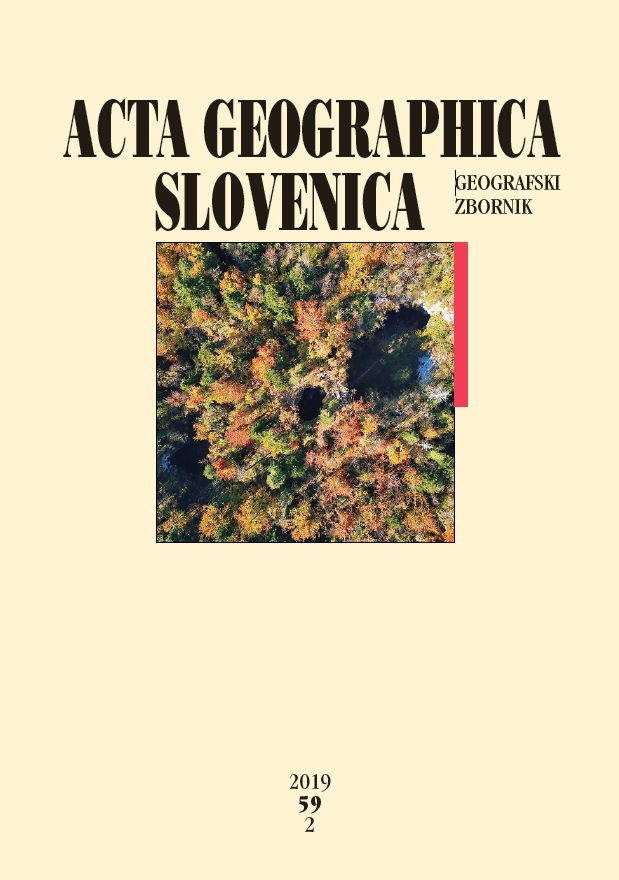Spatial conflicts: Analyzing a burden created by differing land use
DOI:
https://doi.org/10.3986/AGS.5181Keywords:
spatial planning, spatial structure, spatial conflicts, uses of spaces, CLC, natural valueAbstract
The article proposes a procedure for determining the location of potential spatial conflicts. The author presents issues concerning spatial conflicts which may arise as a result of different uses of spaces adjacent to each other. The proposed procedure has been tested on one of the districts of Poland’s Warmińsko-Mazurskie Voivodeship, namely Nidzicki District. In order to determine the use of the space, CLC databases made available by the Chief Environmental Protection Inspectorate were used. Based on them, the use of fragments of space, which were also differentiated due to their natural value, was determined. For the thus described space, a map of burden of potential spatial conflicts was compiled. The proposed method may be used as a tool supporting the processes of space planning and monitoring the environmental changes.
Downloads
References
Abdelgalil, E. A., Cohen, S. I. 2007: Economic development and resource degradation: Conflicts and policies. Socio-Economic Planning Sciences 41-2. DOI: https://doi.org/10.1016/j.seps.2005.10.002
Alston, L. J., Libecap, G. D., Mueller, B. 1999: Titles, conflict, and land use: The development of property rights and land reform on the Brazilian Amazon frontier. Ann Arbor. DOI: https://doi.org/10.3998/mpub.16208
Bergstrom, J. C., Goetz, S. J., Shortle, J. S. (eds.) 2013: Land use problems and conflicts: Causes, consequences and solutions. London, New York.
Biłozor A., Renigier-Biłozor M. 2015: Optimization and polyoptimization in the management of land. Proceedings of the SGEM 2015 GeoConference on Informatics, geoinformatics and remote sensing. Albena.
Bob, U., Bronkhorst, S. 2011: Environmental conflicts: Key issues and management implications. African Journal on Conflict Resolution, 10-2. DOI: https://doi.org/10.4314/ajcr.v10i2.63307
Bogetoft, P., Pruzan, P. 1991: Planning with Multiple Criteria: Investigation, Communication. Copenhagen.
Brown, G., Raymond, C. M. 2014: Methods for identifying land use conflict potential using participatory mapping. Landscape and Urban Planning 122. DOI: https://doi.org/10.1016/j.landurbplan.2013.11.007
Braun, S.,Wimmer, A. 2013: Civil Society Conflicts Environment & Social Conflicts. SSRN Electronic Journal. DOI: https://doi.org/10.2139/ssrn.2655023
Cieslak, I., Szuniewicz, K., Czyża, S. 2016: Analysis of the Variation of the Areas Under Urbanization Pressure Using Entropy Index. Procedia Engineering 161. DOI: https://doi.org/10.1016/j.proeng.2016.08.793
Cieślak I., Szuniewicz K., Gerus-Gościewska M. 2013: Evaluation of the Natural Value of Land Before and after Planning Procedures. Rural Development 6-3.
Cieślak, I. (ed.) 2012: Współczesna waloryzacja przestrzeni zurbanizowanej. Olsztyn.
Cieślak, I., Szuniewicz K., Pawlewicz K., Czyża S. 2017: Change value analysis of natural area indicator in Polish municipalities beased on landuse. Proceedings of the 17th International Multidisciplinary Scientific GeoConference SGEM 2017. Albena. DOI: https://doi.org/10.5593/sgem2017/23
Ciołkosz, A., Bielecka, E. 2005: Pokrycie terenu w Polsce. Bazy danych CORINE Land Cover. Warszawa.
Coppens, T. 2011: Conflict and conflict management in strategic urban projects. Heverlee.
Corine Land Cover 2017. URL: http://clc.gios.gov.pl (1. 5. 2017).
De Groot, R. 2006: Function-analysis and valuation as a tool to assess land use conflicts in planning for sustainable, multi-functional landscapes. Landscape and urban planning 75, 3-4. DOI: https://doi.org/10.1016/j.landurbplan.2005.02.016
Domingo Pastó, I. 2009: Spatial planning as ‘co-evolution: linking expectations, uncertainties, and conflicts. A case study of supra-local plans in the Catalan Pyrenees (Spain). Wageningen.
Braun, S., Wimmer, A. 2013: Civil Society Conflicts Environment & Social Conflicts. SSRN Electronic Journal. DOI: https://doi.org/10.2139/ssrn.2655023
Glasson, J., Marshall, T. 2007: Regional planning. New York.
Hite, J. 1998: Land use conflicts on the urban fringe: Causes and potential resolution. Clemson.
Hopkins, L. D. 2001: Urban development: the logic of making plans. Washington.
Hrvatin, M., Perko, D. 2008: Landscape characteristics of common land in Slovenia. Acta geographica Slovenica 7-32. DOI: https://doi.org/10.3986/AGS48101
Joshi, C. M., de Leeuw, J., van Duren, I. C. 2004: Remote sensing and GIS applications for mapping and spatial modelling of invasive species. Geo-imagery bridging continents, Proceedings of 20th ISPRS congress. Istanbul.
Kennedy, A. 2017: Environmental justice and land use conflict: The governance of mineral and gas resource development. London, New York.
Kieslich, P. J., Hilbig, B. E. 2014: Cognitive conflict in social dilemmas: An analysis of response dynamics. Judgment and Decision Making 9-6.
Leedy, P. D., Ormrod, J. E. 2005: Practical research. Pearson Education.
Mack, R. W., Snyder, R. C. 1957: The Analysis of Social Conflict. Toward an Overview and Synthesis. Conflict Resolution 1-2. DOI://doi.org/10.1177/002200275700100208
Markuszewska, I. 2018. Conflicts between legal policy and rural area management in Poland. Acta geographica Slovenica 58 -1.
NatSchAVO 1995. Naturschutz-Ausgleichsverordnung vom 30. März 1995 (SächsGVBl. S. 148, 196), die durch die Verordnung vom 5. Dezember 2001.
Nolon, S., Ferguson, O., Field, P. 2013: Land in conflict: Managing and resolving land use disputes. Cambridge, Massachusetts.
Smrekar, A., Šmid Hribar, M., Erhartič, B. 2016: Stakeholder conflicts in the Tivoli, Rožnik Hill, and Šiška Hill Protected Landscape Area. Acta geographica Slovenica 56-2. DOI: https://doi.org/10.3986/AGS.895
SMUL 2009. Handlungsempfehlung zur bewertung und bilanzierung von eingriffen im freistaat sachsen, Im Auftrag des Sächsischen Ministeriums für Umwelt und Landwirtschaft. Dresden.
Strumiłło-Rembowska, D., Bednarczyk, M., Cieślak, I. 2014: Data generation of vector maps using a hybrid method of analysis and selection of geodata necessary to optimize the process of spatial planning. Proceedings of the 9th International Conference “Environmental engineering”. Vilnius.
von der Dunk, A., Grêt-Regamey, A., Dalang, T., Hersperger, A. M. 2011: Defining a typology of peri-urban land-use conflicts - A case study from Switzerland. Landscape and urban planning 101-2. DOI: https://doi.org/10.1016/j.landurbplan.2011.02.007
Wehrmann, B. 2008: Land conflicts: A practical guide to dealing with land disputes. Eschborn.
Young, J., Watt, A., Nowicki, P., Alard, D., Clitherow, J., Henle, K., Johnson, R., Laczko, E., McCracken, D., Matouch, S., Niemela, J., Richards, C. 2005: Towards sustainable land use: identifying and managing the conflicts between human activities and biodiversity conservation in Europe. Biodiversity and Conservation 14-7. DOI: https://doi.org/10.1007/s10531-004-0536-z
Downloads
Published
How to Cite
Issue
Section
License

This work is licensed under a Creative Commons Attribution-NonCommercial-NoDerivatives 4.0 International License.






